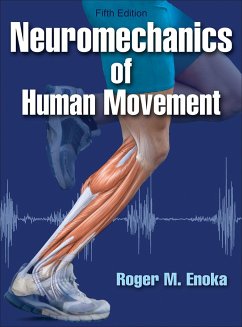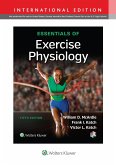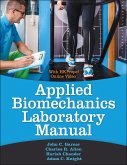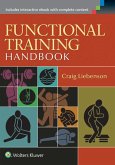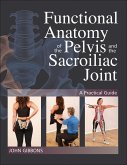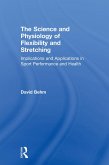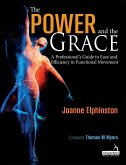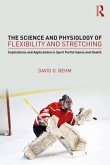Roger M. Enoka
Neuromechanics of Human Movement
Roger M. Enoka
Neuromechanics of Human Movement
- Gebundenes Buch
- Merkliste
- Auf die Merkliste
- Bewerten Bewerten
- Teilen
- Produkt teilen
- Produkterinnerung
- Produkterinnerung
This text draws on the disciplines of neurophysiology and physics to explore how the nervous system controls the actions of muscles to produce human motion in relation to biomechanical principles.
Andere Kunden interessierten sich auch für
![Essentials of Exercise Physiology Essentials of Exercise Physiology]() McArdle, William D., BS, M.Ed, PhDEssentials of Exercise Physiology72,99 €
McArdle, William D., BS, M.Ed, PhDEssentials of Exercise Physiology72,99 €![Applied Biomechanics Lab Manual Applied Biomechanics Lab Manual]() John C. GarnerApplied Biomechanics Lab Manual91,99 €
John C. GarnerApplied Biomechanics Lab Manual91,99 €![Functional Training Handbook Functional Training Handbook]() Craig LiebensonFunctional Training Handbook62,99 €
Craig LiebensonFunctional Training Handbook62,99 €![Functional Anatomy of the Pelvis and the Sacroiliac Joint Functional Anatomy of the Pelvis and the Sacroiliac Joint]() John GibbonsFunctional Anatomy of the Pelvis and the Sacroiliac Joint41,99 €
John GibbonsFunctional Anatomy of the Pelvis and the Sacroiliac Joint41,99 €![The Science and Physiology of Flexibility and Stretching The Science and Physiology of Flexibility and Stretching]() David BehmThe Science and Physiology of Flexibility and Stretching196,99 €
David BehmThe Science and Physiology of Flexibility and Stretching196,99 €![The Power and the Grace The Power and the Grace]() Joanne ElphinstonThe Power and the Grace60,99 €
Joanne ElphinstonThe Power and the Grace60,99 €![The Science and Physiology of Flexibility and Stretching The Science and Physiology of Flexibility and Stretching]() David BehmThe Science and Physiology of Flexibility and Stretching58,99 €
David BehmThe Science and Physiology of Flexibility and Stretching58,99 €-
-
-
This text draws on the disciplines of neurophysiology and physics to explore how the nervous system controls the actions of muscles to produce human motion in relation to biomechanical principles.
Hinweis: Dieser Artikel kann nur an eine deutsche Lieferadresse ausgeliefert werden.
Hinweis: Dieser Artikel kann nur an eine deutsche Lieferadresse ausgeliefert werden.
Produktdetails
- Produktdetails
- Verlag: Human Kinetics Publishers
- Fifth Edition
- Seitenzahl: 504
- Erscheinungstermin: 25. März 2015
- Englisch
- Abmessung: 286mm x 225mm x 32mm
- Gewicht: 1398g
- ISBN-13: 9781450458801
- ISBN-10: 1450458807
- Artikelnr.: 42123401
- Herstellerkennzeichnung
- Libri GmbH
- Europaallee 1
- 36244 Bad Hersfeld
- gpsr@libri.de
- Verlag: Human Kinetics Publishers
- Fifth Edition
- Seitenzahl: 504
- Erscheinungstermin: 25. März 2015
- Englisch
- Abmessung: 286mm x 225mm x 32mm
- Gewicht: 1398g
- ISBN-13: 9781450458801
- ISBN-10: 1450458807
- Artikelnr.: 42123401
- Herstellerkennzeichnung
- Libri GmbH
- Europaallee 1
- 36244 Bad Hersfeld
- gpsr@libri.de
Roger M. Enoka is professor in the department of integrative physiology at the University of Colorado Boulder and a professor in the departments of medicine (geriatrics) and neurology at the University of Colorado Denver. He is also the director of the Neurophysiology of Movement Lab. Previously he was a biomechanist in the department of biomedical engineering at the Cleveland Clinic Foundation and a professor in the department of physiology at the University of Arizona. For more than 30 years, Enoka has focused his research and teaching on the combination of biomechanics and neurophysiology of movement. Internationally known for his achievements as a teacher and researcher, Enoka is the author of approximately 350 journal articles, books, chapters, reviews, and abstracts, including the frequently cited article "Neurobiology of Muscle Fatigue" published in the Journal of Applied Physiology. He is a member of the American College of Sports Medicine, American Physiological Society, International Society of Biomechanics, and Society for Neuroscience. He is also a past president and current member of the American Society of Biomechanics.
Part I. The Force-Motion Relationship
Chapter 1. Describing Motion
Measurement Rules
Motion Descriptors
Constant Acceleration
Up and Down
Scalars and Vectors
Linear and Angular Motion
Curve Fitting and Smoothing
Summary
References
Chapter 2. Movement Forces
Laws of Motion
Describing Forces in Human Movement
Forces Due to Body Mass
Forces Due to the Surroundings
Musculoskeletal Forces
Summary
References
Chapter 3. Movement Analysis
Static Analysis
Dynamic Analysis
Momentum
Work
Summary
References
Chapter 4. Running, Jumping, and Throwing
Walking and Running
Jumping
Throwing and Kicking
Summary
References
Part II. The Motor System
Chapter 5. Excitable Membranes
Essentials of Electricity
Resting Membrane Potential
Neurons
Synaptic Transmission
Electromyography
Summary
References
Chapter 6. Muscle and Motor Units
Muscle
Excitation-Contraction Coupling
Motor Unit
Muscle Mechanics
Summary
References
Chapter 7. Neural Control of Movement
Spinal Reflexes
Automatic Behaviors
Voluntary Actions
Summary
References
Part III. Adaptability of the Motor System
Chapter 8. Acute Adjustments
Warm-Up Effects
Flexibility
Muscle Soreness and Damage
Fatigue
Muscle Potentiation
Arousal
Summary
References
Chapter 9. Chronic Adaptations
Muscle Strength
Muscle Power
Adaptations to Reduced Use
Motor Recovery After Nervous System Injury
Adaptations With Age
Summary
References
Chapter 1. Describing Motion
Measurement Rules
Motion Descriptors
Constant Acceleration
Up and Down
Scalars and Vectors
Linear and Angular Motion
Curve Fitting and Smoothing
Summary
References
Chapter 2. Movement Forces
Laws of Motion
Describing Forces in Human Movement
Forces Due to Body Mass
Forces Due to the Surroundings
Musculoskeletal Forces
Summary
References
Chapter 3. Movement Analysis
Static Analysis
Dynamic Analysis
Momentum
Work
Summary
References
Chapter 4. Running, Jumping, and Throwing
Walking and Running
Jumping
Throwing and Kicking
Summary
References
Part II. The Motor System
Chapter 5. Excitable Membranes
Essentials of Electricity
Resting Membrane Potential
Neurons
Synaptic Transmission
Electromyography
Summary
References
Chapter 6. Muscle and Motor Units
Muscle
Excitation-Contraction Coupling
Motor Unit
Muscle Mechanics
Summary
References
Chapter 7. Neural Control of Movement
Spinal Reflexes
Automatic Behaviors
Voluntary Actions
Summary
References
Part III. Adaptability of the Motor System
Chapter 8. Acute Adjustments
Warm-Up Effects
Flexibility
Muscle Soreness and Damage
Fatigue
Muscle Potentiation
Arousal
Summary
References
Chapter 9. Chronic Adaptations
Muscle Strength
Muscle Power
Adaptations to Reduced Use
Motor Recovery After Nervous System Injury
Adaptations With Age
Summary
References
Part I. The Force-Motion Relationship
Chapter 1. Describing Motion
Measurement Rules
Motion Descriptors
Constant Acceleration
Up and Down
Scalars and Vectors
Linear and Angular Motion
Curve Fitting and Smoothing
Summary
References
Chapter 2. Movement Forces
Laws of Motion
Describing Forces in Human Movement
Forces Due to Body Mass
Forces Due to the Surroundings
Musculoskeletal Forces
Summary
References
Chapter 3. Movement Analysis
Static Analysis
Dynamic Analysis
Momentum
Work
Summary
References
Chapter 4. Running, Jumping, and Throwing
Walking and Running
Jumping
Throwing and Kicking
Summary
References
Part II. The Motor System
Chapter 5. Excitable Membranes
Essentials of Electricity
Resting Membrane Potential
Neurons
Synaptic Transmission
Electromyography
Summary
References
Chapter 6. Muscle and Motor Units
Muscle
Excitation-Contraction Coupling
Motor Unit
Muscle Mechanics
Summary
References
Chapter 7. Neural Control of Movement
Spinal Reflexes
Automatic Behaviors
Voluntary Actions
Summary
References
Part III. Adaptability of the Motor System
Chapter 8. Acute Adjustments
Warm-Up Effects
Flexibility
Muscle Soreness and Damage
Fatigue
Muscle Potentiation
Arousal
Summary
References
Chapter 9. Chronic Adaptations
Muscle Strength
Muscle Power
Adaptations to Reduced Use
Motor Recovery After Nervous System Injury
Adaptations With Age
Summary
References
Chapter 1. Describing Motion
Measurement Rules
Motion Descriptors
Constant Acceleration
Up and Down
Scalars and Vectors
Linear and Angular Motion
Curve Fitting and Smoothing
Summary
References
Chapter 2. Movement Forces
Laws of Motion
Describing Forces in Human Movement
Forces Due to Body Mass
Forces Due to the Surroundings
Musculoskeletal Forces
Summary
References
Chapter 3. Movement Analysis
Static Analysis
Dynamic Analysis
Momentum
Work
Summary
References
Chapter 4. Running, Jumping, and Throwing
Walking and Running
Jumping
Throwing and Kicking
Summary
References
Part II. The Motor System
Chapter 5. Excitable Membranes
Essentials of Electricity
Resting Membrane Potential
Neurons
Synaptic Transmission
Electromyography
Summary
References
Chapter 6. Muscle and Motor Units
Muscle
Excitation-Contraction Coupling
Motor Unit
Muscle Mechanics
Summary
References
Chapter 7. Neural Control of Movement
Spinal Reflexes
Automatic Behaviors
Voluntary Actions
Summary
References
Part III. Adaptability of the Motor System
Chapter 8. Acute Adjustments
Warm-Up Effects
Flexibility
Muscle Soreness and Damage
Fatigue
Muscle Potentiation
Arousal
Summary
References
Chapter 9. Chronic Adaptations
Muscle Strength
Muscle Power
Adaptations to Reduced Use
Motor Recovery After Nervous System Injury
Adaptations With Age
Summary
References

